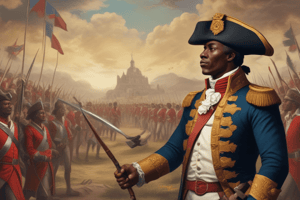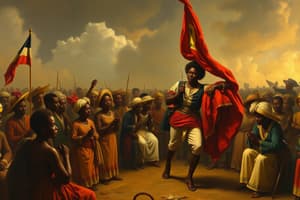Podcast
Questions and Answers
Which of the following is the most accurate description of the impact of the Haitian Revolution on enslaved people in the Americas?
Which of the following is the most accurate description of the impact of the Haitian Revolution on enslaved people in the Americas?
- It encouraged enslavers to offer more rights to enslaved people to prevent revolts.
- It demonstrated that enslaved people could successfully revolt and establish their own nation. (correct)
- It led to the immediate abolition of slavery in all French colonies.
- It resulted in the United States immediately recognizing Haiti as a sovereign nation.
How did the Fugitive Slave Act of 1850 impact the Underground Railroad?
How did the Fugitive Slave Act of 1850 impact the Underground Railroad?
- It effectively shut down the Underground Railroad by imposing severe penalties.
- It legalized the Underground Railroad in states where slavery was illegal.
- It made assisting runaway enslaved people illegal, but resistance continued. (correct)
- It provided funding for the Underground Railroad to expand its operations.
What was the significance of the Amistad Rebellion and subsequent Supreme Court case?
What was the significance of the Amistad Rebellion and subsequent Supreme Court case?
- It established a legal precedent where U.S. courts sided with the freedom of enslaved Africans. (correct)
- It led to the immediate abolition of slavery in the United States.
- It weakened the abolitionist movement due to the violent nature of the revolt.
- It resulted in the United States government paying reparations to the captured Africans.
How did slave codes contribute to the oppression of enslaved people?
How did slave codes contribute to the oppression of enslaved people?
What is the central argument behind the concept of race as a social construct?
What is the central argument behind the concept of race as a social construct?
How did the 13th Amendment's loophole impact the Black community after the Civil War?
How did the 13th Amendment's loophole impact the Black community after the Civil War?
In what ways did Jim Crow laws undermine the rights granted by the Reconstruction Amendments?
In what ways did Jim Crow laws undermine the rights granted by the Reconstruction Amendments?
What were some of the primary motivations behind the Great Migration?
What were some of the primary motivations behind the Great Migration?
How did the Harlem Renaissance contribute to the broader struggle for civil rights and racial equality?
How did the Harlem Renaissance contribute to the broader struggle for civil rights and racial equality?
What does W.E.B. Du Bois mean by "double consciousness?"
What does W.E.B. Du Bois mean by "double consciousness?"
Flashcards
The Haitian Revolution
The Haitian Revolution
Successful slave revolt where enslaved Africans overthrew French rule, leading Haiti to become the first independent Black republic in the Americas.
The Underground Railroad
The Underground Railroad
A network of secret routes and safe houses that helped enslaved people escape to free states and Canada, led by Harriet Tubman.
The Amistad Rebellion
The Amistad Rebellion
Captured Africans aboard the Amistad rebelled; the U.S. Supreme Court ruled in their favor, marking a victory against slavery.
Slave Codes
Slave Codes
Signup and view all the flashcards
Social Construction of Race
Social Construction of Race
Signup and view all the flashcards
Reconstruction Amendments
Reconstruction Amendments
Signup and view all the flashcards
Jim Crow Laws & Black Codes
Jim Crow Laws & Black Codes
Signup and view all the flashcards
The Great Migration
The Great Migration
Signup and view all the flashcards
Harlem Renaissance
Harlem Renaissance
Signup and view all the flashcards
Black Wall Street Massacre
Black Wall Street Massacre
Signup and view all the flashcards
Study Notes
- African American history is a story of struggle, resilience, and change.
- From enslavement to Reconstruction to segregation to cultural rebirth, Black Americans have fought for justice against huge odds.
The Haitian Revolution (1791-1804)
- The only successful slave revolt happened in Haiti, with enslaved Africans overthrowing French rule.
- Toussaint Louverture, a formerly enslaved man, led the fight, and Haiti became the first independent Black republic in the Americas in 1804.
- The victory of Haiti terrified white enslavers in the U.S., proving enslaved people could fight back and win.
- Haiti's victory inspired resistance across the Americas, including slave rebellions in the U.S.
- The U.S. refused to recognize Haiti for decades to discourage similar uprisings.
The Underground Railroad & Harriet Tubman
- The Underground Railroad was a network of secret routes and safe houses that helped enslaved people escape to free states and Canada.
- Harriet Tubman, a formerly enslaved woman, made 13 missions to rescue over 70 people.
- Tubman risked her life for the community, not just herself.
- The Fugitive Slave Act (1850) made it illegal to help enslaved people escape, but many still resisted.
The Amistad Rebellion (1839)
- Captured Africans aboard the Amistad ship rebelled and took control, but were later caught and put on trial in the U.S. Supreme Court.
- Former President John Quincy Adams argued for their freedom, and the court ruled in their favor showing enslaved people were not powerless.
- This was one of the first times U.S. courts sided with Black freedom, setting a legal precedent.
- The case was a major victory for abolitionists.
Slave Codes & Black Abolitionists
- Slave codes were laws meant to keep enslaved people under control by forbidding them from learning, gathering, or traveling without permission.
- Black abolitionists like Frederick Douglass and Sojourner Truth fought against these laws.
- The fact that slaveholders banned education shows they knew knowledge was power.
- Abolitionists told their own stories, proving their intelligence and humanity to change public opinion on slavery, especially in the North.
The Social Construction of Race
- Race is not a biological fact—it was created as a system of power to justify slavery.
- Laws in early America ensured Black people would remain enslaved and white people would remain in power.
- Racial categories made in the 1600s shaped who had rights and who didn't.
- After slavery, race justified segregation and discrimination, leading to racial inequality today.
The Reconstruction Amendments (13th, 14th, 15th)
- After the Civil War, three major amendments were passed.
- 13th Amendment (1865): Ended slavery but left a loophole allowing forced labor in prisons.
- 14th Amendment (1868): Gave Black people citizenship.
- 15th Amendment (1870): Gave Black men the right to vote, but states found ways to block it.
- Racist laws weakened the amendments with the prison loophole allowing mass incarceration of Black people.
- Black political power grew briefly until white supremacists suppressed it.
Jim Crow Laws & Black Codes
- After slavery, new laws maintained white dominance.
- These included segregation laws, literacy tests, and poll taxes to block Black voting.
- Jim Crow was slavery by another name, treating Black people as second-class citizens.
- Segregation shaped wealth, education, and jobs, and weren't overturned until the Civil Rights Movement in the 1960s.
The Great Migration (1910-1970)
- Millions of Black Americans left the South for cities like Detroit, Chicago, and New York for better jobs and to escape racism.
- This migration transformed America—Black culture became more visible in music, art, and activism.
- It led to political power in northern cities, setting the stage for the Civil Rights Movement.
- Racism followed, and redlining kept Black families out of wealthier areas.
The Harlem Renaissance (1920s-1930s)
- A cultural explosion occurred where Black writers, musicians, and artists expressed their identity and struggles.
- Figures like Langston Hughes and Duke Ellington redefined what it meant to be Black in America.
- It gave Black people a voice and pride in their culture and challenged racist ideas and stereotypes in media.
- It set the foundation for modern Black art, music, and literature.
W.E.B. Du Bois & Double Consciousness
- W.E.B. Du Bois described double consciousness as seeing yourself through your own eyes and the lens of racism.
- It explains the struggle of being both Black and American in a racist society.
- It helps understanding of why Black identity and self-perception have been shaped by oppression still applying today with code-switching in white spaces.
Black Wall Street & The Tulsa Race Massacre (1921)
- Tulsa, Oklahoma, had a thriving Black business district known as Black Wall Street.
- In 1921, white mobs burned it down, killing hundreds and destroying Black wealth.
- The event was erased from history books, showing how white violence was used to stop Black success.
- The loss of Black wealth impacts Black communities today.
Studying That Suits You
Use AI to generate personalized quizzes and flashcards to suit your learning preferences.




